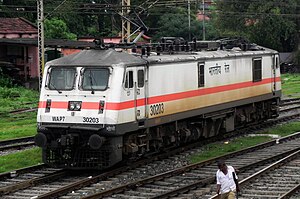IR class WAP-7
| WAP-7 | |
|---|---|
|
WAP-7 in Ghomo, Jharkhand state
|
|
| Numbering: | 30201–30533 (as of February 14, 2017 including ordered vehicles) |
| Number: | 333 (as of February 14, 2017 including ordered vehicles) |
| Manufacturer: | CLW |
| Year of construction (s): | since 2000 |
| Axis formula : | Co'Co ' |
| Gauge : | 1676 mm |
| Length over buffers: | 20,562 mm |
| Height: | 4255 mm (with lowered pantographs) |
| Width: | 3152 mm |
| Trunnion Distance: | 12,000 mm |
| Bogie axle base: | 3700 mm |
| Total wheelbase: | 15,700 mm |
| Service mass: | 123 t |
| Wheel set mass : | 20.5 t |
| Top speed: | 130 km / h |
| Traction power: | 4.7 MW |
| Starting tractive effort: | 353 kN |
| Driving wheel diameter: | 1092 mm |
| Motor type: | 6FRA 6068 |
| Motor type: | Asynchronous three-phase motor |
| Power system : | 25 kV 50 Hz |
| Drive: | Pawbearing drive |
| Brake: | Davies and Metcalfe Direct Air Brake, Indirect Air Brake and Parking Brake |
| Speedometer: | Hasler Memotel |
| Control: | FIG. MICAS-S2 |
The Indian Railways WAP-7 is an electric locomotive from the Indian Chittaranjan Locomotive Works (CLW). It is a variant of the WAG-9 freight locomotive , which is equipped with a gear ratio for passenger transport and has a top speed of 140 km / h. It is mainly used on heavy express trains such as the Superfast trains .
history
In the mid-1990s, ABB supplied 11 WAP-5 passenger locomotives and 22 WAG-9 freight locomotives to Indian Railways. As part of the ten-year technology transfer contract associated with the supply contract, which was transferred to Adtranz along with the rest of ABB's rail business , Indian Railways' electric locomotive factory, Chittaranjan Locomotive Works, developed a faster variant of the WAG-9 for passenger train traffic.
technology
The locomotive has an output of 6350 hp and is designed for the transport of heavy express trains with 24 to 26 carriages at a speed of 130 km / h. The axle travel mass is 20.5 t. The drive train consists of an underfloor-mounted traction transformer with two oil-cooled converters in GTO technology, similar to the SBB Lok 2000 , but with two-point switching.
The bogies with coil springs in the primary stage and Flexicoil coil springs in the secondary stage are similar to those of the Blue Tiger . The tensile forces are transferred from the bogie frame to the locomotive body with tie rods, as in the Bombardier Traxx locomotives. The drive takes place with paw-bearing motors , which are identical to those of the WAG-9. The transmission ratio is 72:20. The fans are supplied with energy by a three-channel static auxiliary converter . Centrifugal separators prevent dust from entering the engine room.
The locomotive is controlled by 19 microprocessor computers in MICAS-S2 technology from ABB. The software used is identical to that of the WAP-5 and WAG-9, except for the control of the converters.
commitment
The first locomotive was completed in 2000 and assigned to the Gomoh depot in the state of Jharkhand, which is in the region of the manufacturing plant. Compared to the standard version, this locomotive has a slightly lower pulling force of 323 kN and a lower output of 6125 hp. The locomotives were later delivered to all of the larger depots that provide passenger train services with electric locomotives. The series is still being built in 2016.
Web links
Individual evidence
- ↑ a b Allottment of Electric Locomotives. (No longer available online.) Government of India, archived from the original on March 13, 2016 ; accessed on March 13, 2016 . Info: The archive link was inserted automatically and has not yet been checked. Please check the original and archive link according to the instructions and then remove this notice.
- ↑ CLW Official Website. (No longer available online.) Archived from the original on March 9, 2016 ; accessed on March 13, 2016 . Info: The archive link was inserted automatically and has not yet been checked. Please check the original and archive link according to the instructions and then remove this notice.
- ^ Electric Locomotive Classes - AC: WAP-7. In: IRFCA. Retrieved March 13, 2016 .
- ↑ CLW - Locomotive Software Information. Archived from the original on March 13, 2016 ; accessed on March 13, 2016 .
